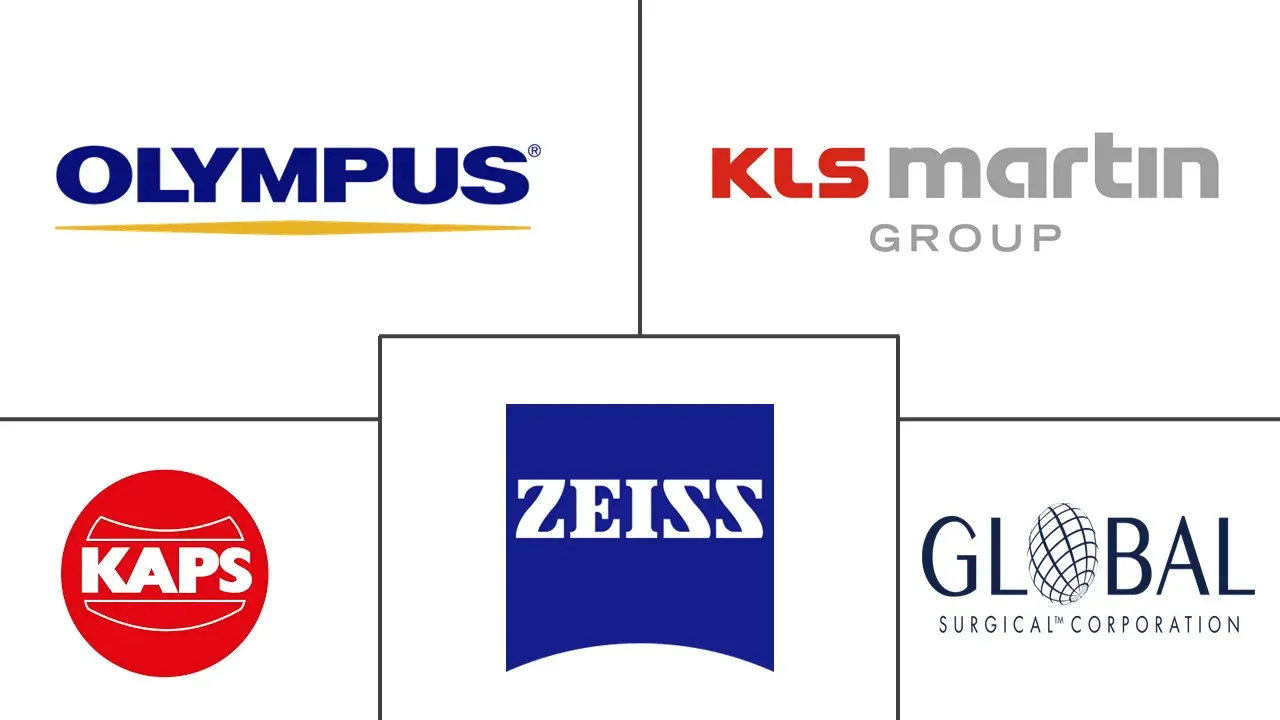Microsurgical Instruments Market Size and Share
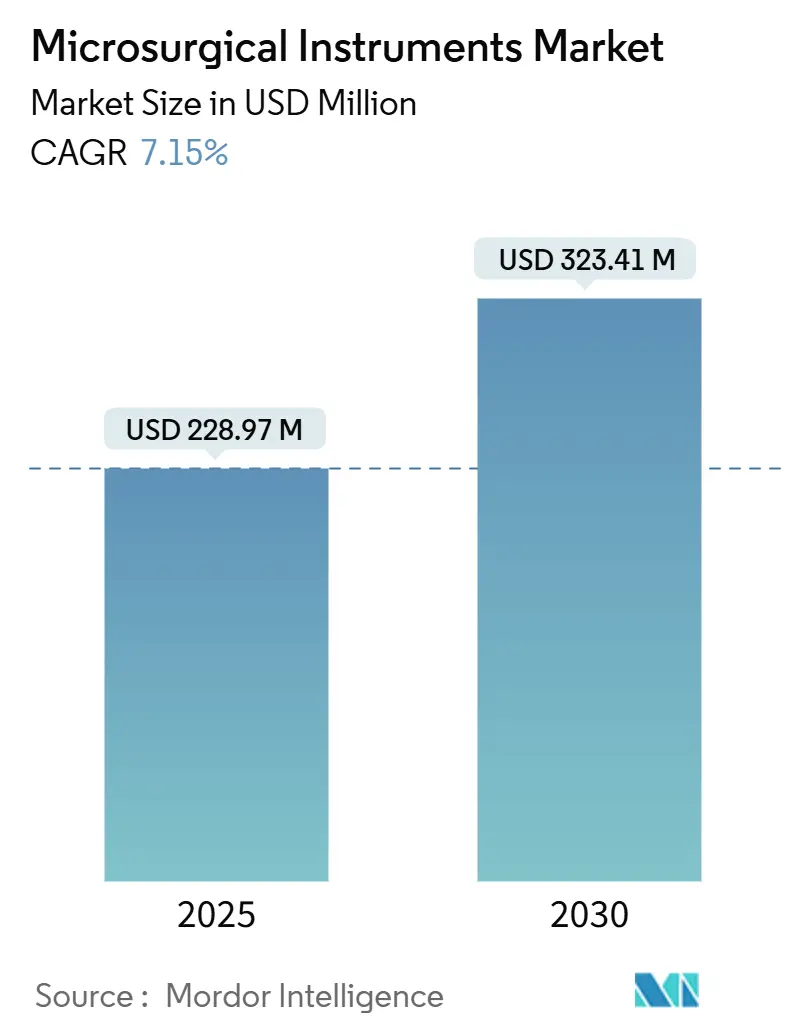
Microsurgical Instruments Market Analysis by Mordor Intelligence
The global microsurgical instruments market was valued at USD 228.97 million in 2025 and is forecast to advance to USD 323.41 million by 2030, reflecting a robust 7.15% CAGR over the period. Escalating uptake of precision-based surgical techniques, rapid integration of 4K/3D digital microscopy, and rising volumes of chronic-disease-related interventions continue to expand demand for highly specialized instruments. Hospitals and teaching centers continue to refresh capital equipment fleets with AI-enabled operating microscopes, while ambulatory surgical centers lean on compact, workflow-oriented sets to migrate complex cases to outpatient settings. The competitive field shows purposeful R&D spending on ergonomic designs, bio-resorbable micro-suture materials, and voice-controlled visualization units to differentiate offerings. Manufacturers must, however, maneuver through stringent Class III approval pathways, making early engagement with regulators and risk-sharing partnerships with providers vital to sustaining innovation momentum.
Key Report Takeaways
- By product category, Operating Microscopes led with 29.52% of microsurgical instruments market share in 2024; Micro Sutures are projected to expand at a 9.25% CAGR through 2030.
- By microsurgery type, Ophthalmic procedures accounted for a 30.53% slice of the microsurgical instruments market size in 2024, while Orthopedic microsurgery is poised to grow at a 10.35% CAGR to 2030.
- By end user, Hospitals held 53.82% revenue share in 2024; Ambulatory Surgical Centers exhibit the fastest growth at 8.26% CAGR.
- By geography, North America commanded 38.82% revenue share in 2024; Asia-Pacific is forecast to climb at a 9.62% CAGR through 2030.
Global Microsurgical Instruments Market Trends and Insights
Drivers Impact Analysis
| Driver | (~) % Impact on CAGR Forecast | Geographic Relevance | Impact Timeline |
|---|---|---|---|
| Rising Surgical Volumes & Chronic Disease Incidence | +1.8% | Global, with higher impact in APAC | Long term (≥ 4 years) |
| Technological Advances In Digital Microscopes & Robotics | +1.5% | North America & EU, expanding to APAC | Short term (≤ 2 years) |
| Growing Demand For Minimally-Invasive Procedures | +1.3% | Global, led by developed markets | Medium term (2-4 years) |
| 4K/3-D OR Integration Accelerating Micro-Instrument Upgrades | +0.8% | North America & EU | Short term (≤ 2 years) |
| Emergence Of Bio-Resorbable Micro-Sutures | +0.6% | Global, early adoption in research centers | Long term (≥ 4 years) |
| Source: Mordor Intelligence | |||
Microsurgery Advantage Over Conventional Surgery
Clinical evidence shows sub-millimeter accuracy translating into lower complication rates and faster recovery, positioning the microsurgical instruments market for sustained adoption. The ETcath robotic platform identifies lesions with 0.1 mm precision, surpassing manual limits and reinforcing the economic rationale for capital purchases. Multitasking devices such as “the flute,” which replaces three instruments in one, reduce setup time and operating-room congestion. Hospitals leverage these outcome gains to negotiate favorable reimbursements, thereby accelerating replacement cycles. Specialty clinics apply microsurgical reconstruction to improve functional and aesthetic results that standard techniques struggle to replicate. As insurers reimburse for value-based metrics, instrument vendors that document reduction in adverse events enjoy an edge when new tenders are issued.
Rising Surgical Volumes & Chronic Disease Incidence
Population aging and the global diabetes burden underpin climbing procedure counts, ensuring multiyear velocity for the microsurgical instruments market. China’s health expenditure outlook of USD 33.4 trillion by 2060 signals large equipment pools across tertiary centers[1]BMC Health Services Research, “Forecast of Total Health Expenditure on China’s Ageing Population,” biomedcentral.com. Diabetic retinopathy drives a high baseline of retinal microsurgery, while coronary artery bypass and tumor resections require nerve-sparing precision that legacy tools cannot deliver. Governments in Asia allocate procurement budgets for ophthalmic and cardiovascular suites, creating attractive bulk-purchase opportunities. Western systems, although mature, still see growth from revision surgeries and longer life expectancy. Device makers respond by tailoring starter kits that bundle microscopes, forceps, and bio-resorbable sutures to lower adoption friction in mid-tier facilities.
Technological Advances in Digital Microscopes & Robotics
Next-generation visualization, force-feedback robotic arms, and AI-driven image recognition raise the performance ceiling for complex procedures, deepening penetration of the microsurgical instruments market. Intuitive Surgical’s da Vinci 5 force-feedback module cuts tissue stress by 43% while easing novice suturing skills acquisition. Hyperspectral imaging, able to reveal sub-surface vascularity, guides neurosurgeons around eloquent cortex and reduces postoperative deficits. Vendors embed 4K sensors and cloud-linked analytics to auto-document key procedural steps, supporting audit trails and continuous learning loops. Early adopters in North America generate peer-reviewed data sets that speed wider reimbursement approvals. Supply chains integrate modular upgrades so existing systems can receive software enhancements without full hardware replacement, controlling lifecycle costs for providers.
Growing Demand for Minimally-Invasive Procedures
Patients and payers favor minimally-invasive routes that lessen scarring, shorten stays, and curtail infection risk, driving new-case volume to the microsurgical instruments market. Endoluminal robotic systems enter through natural orifices, eliminating large incisions and broadening indications previously considered too morbid[3]Noah Medical, “2025 Predictions in Healthcare: The Rise of Endoluminal Robotics,” noahmed.com. Academic centers deploy the Symani system for delicate flap reconstructions, demonstrating suture diameters of 40 µm now possible in outpatient theatres[2]American Hospital Association, “3 Ways Robotic Surgery Is Changing Health Care This Year,” aha.org. Virtuoso Surgical advanced needle-sized manipulators into first-in-human bladder tumor removal, showcasing en bloc resection in anatomically confined spaces. These successes spark payer inclusion of additional CPT codes, encouraging equipment acquisitions at ASCs where procedure mix upgrades raise operating margins. Training programs adapt simulation modules to expand the pool of surgeons proficient in ultra-fine instrument handling.
Restraints Impact Analysis
| Restraint | (~) % Impact on CAGR Forecast | Geographic Relevance | Impact Timeline |
|---|---|---|---|
| High Cost Of Advanced Microsurgical Systems | -1.8% | Global, more pronounced in emerging markets | Short term (≤ 2 years) |
| Stringent Device-Approval Pathways (Class III) | -1.2% | Global, varying by regulatory jurisdiction | Medium term (2-4 years) |
| Shortage Of Trained Microsurgeons In Emerging Markets | -0.9% | APAC, Latin America, MEA | Long term (≥ 4 years) |
| Budget Shift Toward Robotic Platforms Cannibalising Manual Sets | -0.7% | North America & EU primarily | Medium term (2-4 years) |
| Source: Mordor Intelligence | |||
High Cost of Advanced Microsurgical Systems
Premium robotic microscopes command list prices exceeding USD 1 million, while maintenance contracts and sterile consumables can double ten-year ownership cost. Emerging-market hospitals divert limited capital toward essential imaging or ICU beds, leaving microsurgical upgrades on deferred wish lists. Smaller North American community facilities also weigh volume thresholds before committing to full suites, opting instead for refurbished units that offer limited functionality. Vendors counteract sticker shock with pay-per-use leasing, profit-sharing models, and modular build-outs that start with core optics then add robotic arms later. Government procurement grants tied to quality-of-care targets partially offset capex barriers, yet parity with lower-cost manual sets may take additional cycles.
Stringent Device-Approval Pathways (Class III)
The FDA’s PMA process demands rigorous clinical evidence, submission fees, and multi-year timelines that elongate return-on-investment horizons for microsurgical innovators. Similar hurdles appear in Europe’s MDR and Japan’s Pharmaceutical and Medical Device Act, causing “device lag” between first-in-class launches and global rollouts. Start-ups must devote scarce funds to regulatory consultants and large animal trials before human deployment, often prompting partnerships with larger strategics for dossier support. While high standards safeguard patients, they slow iterative releases, meaning surgeons may rely on older models longer. Companies increasingly design clinical protocols with global harmonization in mind, streamlining evidence packages to satisfy multiple authorities concurrently.
Segment Analysis
By Product: Operating Microscopes Lead Digital Integration
Operating Microscopes retained a commanding 29.52% microsurgical instruments market share in 2024, underpinned by continuous infusion of 4K visualization, augmented-reality overlays, and AI-guided autofocus. The segment captured USD 67 million of the microsurgical instruments market size in 2025 and is charted to expand steadily as neurosurgeons and ophthalmologists adopt robotics-ready optics suites. Segment expansion also rides on multi-disciplinary use; ENT and plastic surgeons leverage shared microscopes within hybrid theatres, boosting utilization rates and replacement frequency.
Micro Sutures, bolstered by bio-resorbable polymers that curb foreign-body reactions, are set to outpace through their 9.25% CAGR, particularly in nerve grafting and vascular anastomosis cases. Micro Forceps and Micro Needle Holders benefit from titanium construction and haptic-enhanced grips, alleviating hand fatigue during six-hour reconstructive sessions. Rounding out portfolios, Micro Scissors and Micro Vessel Clamps evolve with diamond-like coatings that preserve sharpness after 1,000 sterilization cycles, while specialty retractors address narrow anatomical corridors in pediatric microsurgery. Collectively, these advancements reinforce recurring revenue streams from consumables, service contracts, and software upgrades, providing vendors with balanced growth across instrument categories.
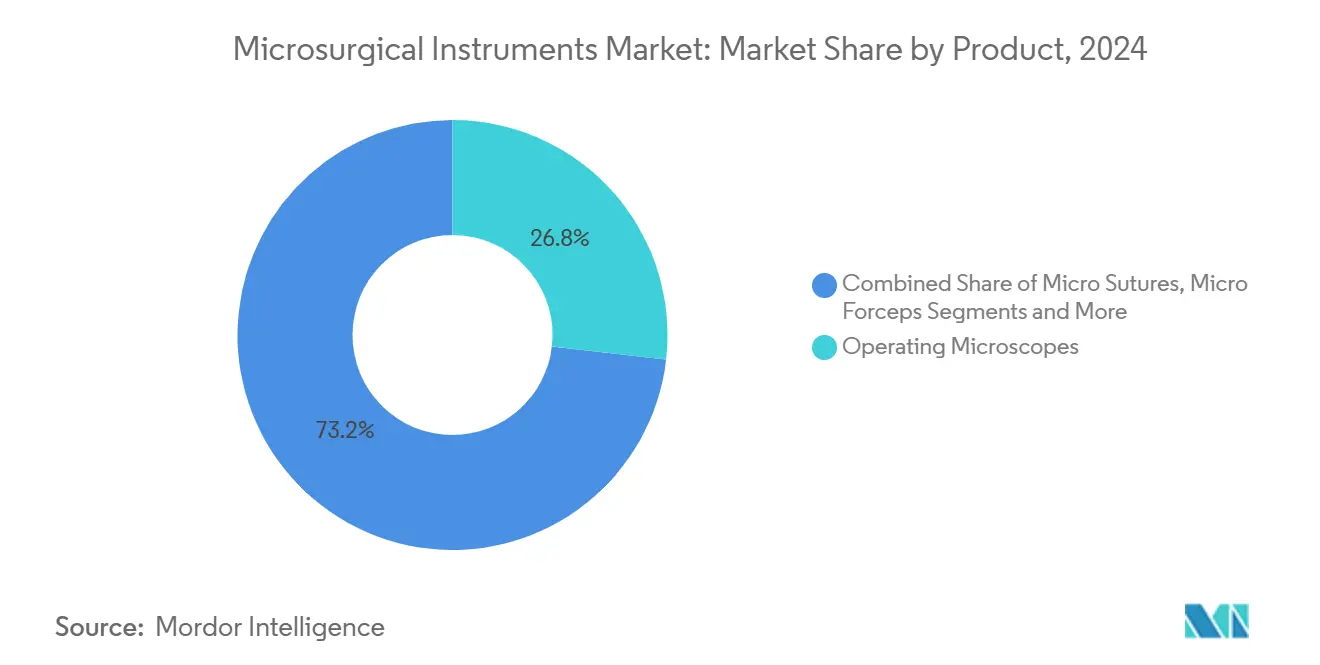
Note: Segment shares of all individual segments available upon report purchase
By Microsurgery Type: Orthopedic Growth Outpaces Traditional Leaders
Ophthalmic procedures dominated revenue with a 30.53% microsurgical instruments market share in 2024 and generated USD 70 million of the microsurgical instruments market size during 2025. Continuous cataract case flow, coupled with complex retinal detachment repairs, anchors volume in mature economies and in fast-growing Asian ophthalmology chains. The procedural baseline makes eye surgery a bellwether for next-gen instrument acceptance; 3D heads-up displays migrated from retina suites into corneal transplant and glaucoma units within two years of launch.
Orthopedic microsurgery, advancing at a 10.35% CAGR, leverages high-resolution imaging and ultra-thin saw blades to perform ligament reconstructions with millimeter precision, reducing revision rates. Peripheral nerve transfers, once confined to academic centers, move into community hospitals as standardized kits arrive. Plastic & Reconstructive teams deploy super-microsurgical tools to revascularize free flaps under 0.8 mm diameter, shortening ischemia time and driving adoption of automated coupler devices. ENT, neurological, and urological specialties tap similar advancements, each reinforcing supplier incentive to maintain robust multi-specialty support programs that widen total addressable revenue.
Orthopedic growth momentum is accelerated by payer recognition of functional benefits that outweigh initial costs; CMS reimbursement of ambulatory shoulder arthroplasty catalyzed install bases in high-volume ASCs. Sports-medicine clinics add nerve graft modules to routine anterior cruciate ligament procedures, expanding per-case instrument spend. By aligning product roadmaps with these inter-disciplinary trends, vendors maximize cross-selling potential and lock-in long-term service agreements, reinforcing the defensibility of the microsurgical instruments market leadership positions they hold.
By End User: ASCs Challenge Hospital Dominance
Hospitals captured 53.82% revenue in 2024, equating to USD 123 million of the microsurgical instruments market size in 2025, reflecting their role as referral hubs for high-acuity cases that demand multidisciplinary resources. Academic medical centers, which often act as early adopters, influence regional purchasing norms and set clinical benchmarks that ripple into surrounding community hospitals.
Yet Ambulatory Surgical Centers register the fastest expansion at 8.26% CAGR as minimally-invasive techniques enable complex cases such as shoulder arthroplasty and peripheral nerve decompressions to shift to outpatient pathways. Lower facility fees, same-day discharge, and streamlined staffing models create compelling economics for payers and patients alike. Specialty Clinics focus on high-volume aesthetics, ophthalmology, or fertility preservation and differentiate by offering concierge-level recovery packages that integrate microsurgical precision for superior cosmetic outcomes. Research institutes, while contributing modest revenue, punch above their weight in shaping technique evolution and validating prototypes that later achieve mainstream commercialization.
ASCs gain negotiating leverage by bundling procedure volumes and equipment commitments, prompting suppliers to craft subscription models that bundle disposables, software updates, and remote servicing. Hospitals respond by emphasizing complex case portfolios—skull-base tumor resections or composite tissue allotransplantations—requiring capital-intensive instrument sets that ASCs cannot yet replicate. This dynamic ensures both site-of-service segments will remain pivotal demand drivers, sustaining long-term growth in the microsurgical instruments market.
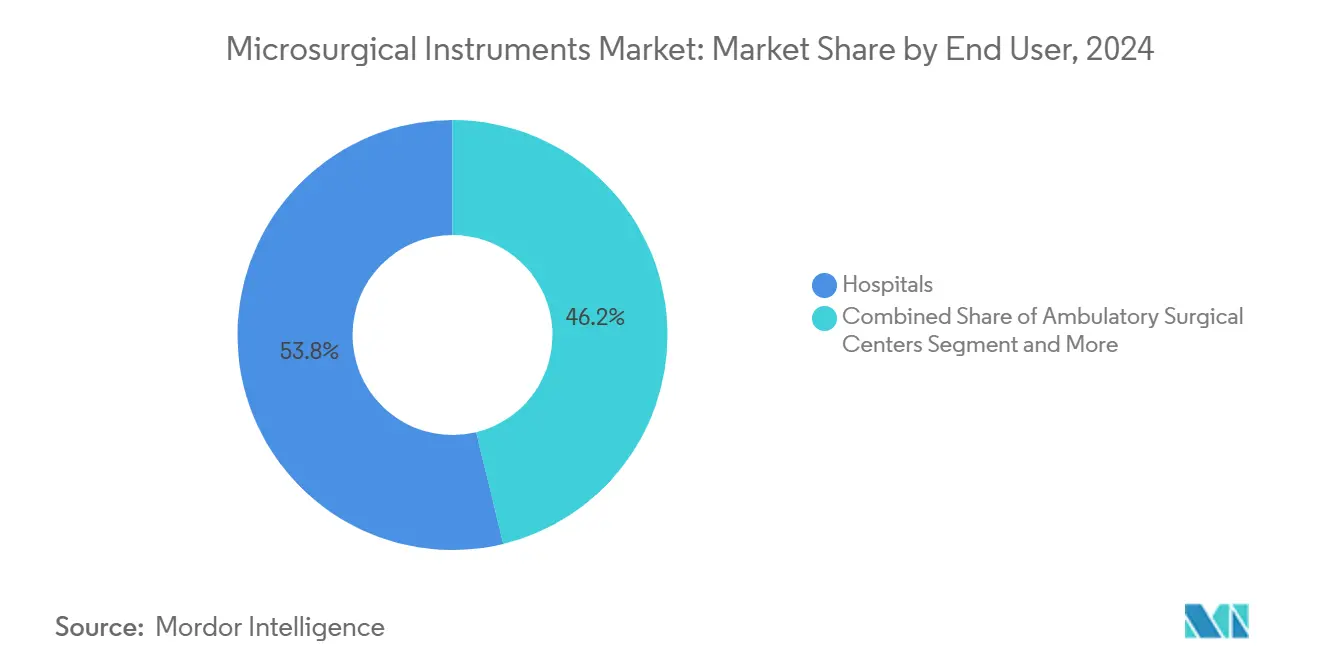
Note: Segment shares of all individual segments available upon report purchase
Geography Analysis
North America generated 38.82% of 2024 revenue, supported by entrenched OR digitization and favorable reimbursement that covers high-ticket visualization platforms. Regional teaching alliances, such as Cleveland Clinic’s collaboration with optics manufacturers, pilot augmented-reality guidance that feeds directly into procurement pathways across affiliated hospitals. Site-of-service migration continues unabated; ASCs now execute more than 60% of rotator cuff repairs, ensuring replacement demand for compact microscopes and single-use suture cartridges. The microsurgical instruments market maintains pricing power here due to value-based contracting, where lower readmission rates secure bonus payments that offset premium device costs.
Europe remains the second-largest buyer pool, with strong adoption in Germany, France, and the Nordics. The region leans on rigorous surgeon credentialing and centralized tender frameworks that prioritize lifecycle cost, pushing vendors to extend warranty periods and offer predictive maintenance packages. EU MDR compliance expenses elevate barriers for new entrants, indirectly protecting incumbent share. Growth, however, is more tempered at mid-single-digit rates as austerity constraints linger in Southern Europe. That drag is partially offset by expanding private hospital networks in Poland and the Czech Republic, which often emulate German standards and thus purchase top-tier microscopes.
Asia-Pacific posts the highest CAGR at 9.62%, buoyed by rapid healthcare infrastructure expansion in China and India. Government initiatives such as China’s Healthy China 2030 blueprint and India’s Ayushman Bharat insurance scheme enlarge addressable patient pools. Chinese class-III medical zones grant tax incentives for local device assembly, enabling foreign brands to shorten lead times and capture provincial tenders. Rising middle-class expectations accelerate penetrative depth in cataract and refractive surgery, bolstering ophthalmic instrument imports. Local start-ups, often staffed by returnee engineers, collaborate with tertiary hospitals to co-develop cost-effective microscopes, injecting competitive pressure yet broadening overall adoption. Japan and South Korea, mature but aging societies, drive replacement sales as facilities swap first-generation digital scopes for robotics-ready variants, preserving regional unit shipment volume.
South America delivers steady but moderate growth, dominated by Brazil’s public-private partnerships that renew capital equipment across flagship hospitals in São Paulo and Rio de Janeiro. Currency volatility occasionally delays tenders, urging vendors to consider financing denominated in local reais to secure orders. Middle East & Africa represent nascent opportunity pockets, particularly in Gulf Cooperation Council states where sovereign health visions fund new transplant and oncology centers requiring state-of-the-art microsurgical tools. In Sub-Saharan Africa, NGO-supported cataract camps create episodic demand for portable microscopes, setting the groundwork for future up-selling once permanent eye-care centers are established. Across all geographies, the microsurgical instruments market benefits from cross-border surgeon fellowships that disseminate best practices and subsequently influence procurement wish lists in home countries.
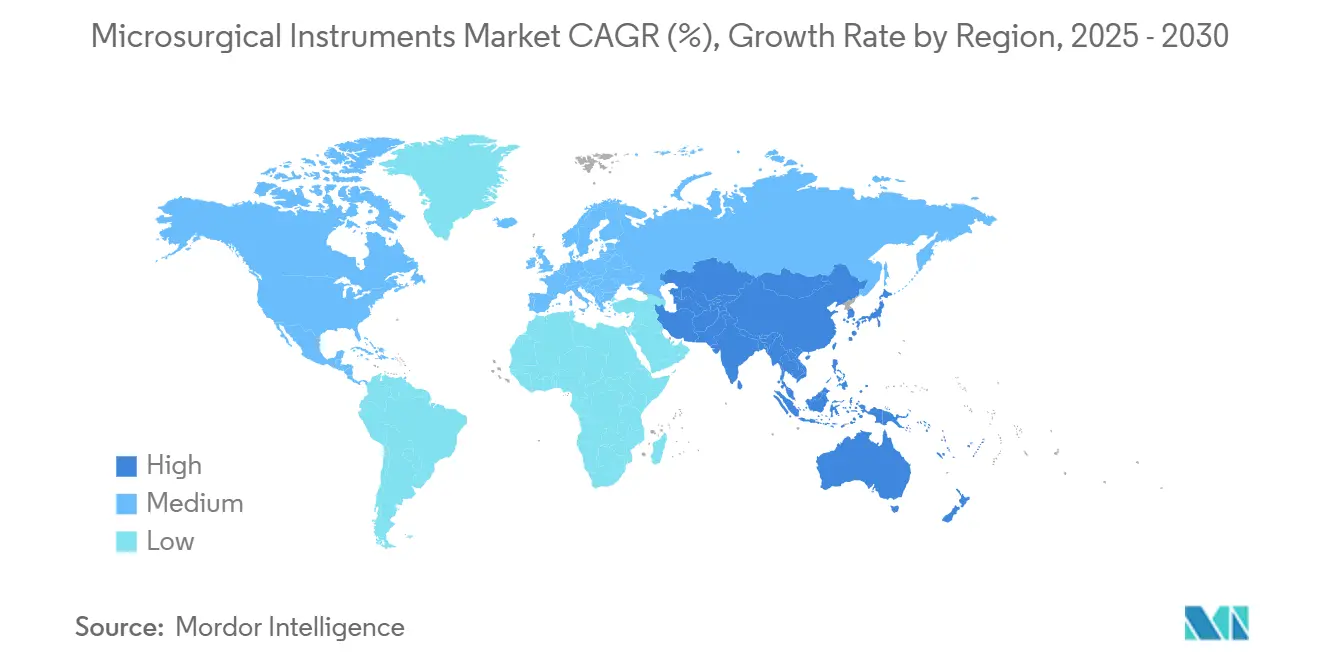
Competitive Landscape
Competition is moderate, with top suppliers controlling meaningful but not overwhelming share, ensuring active jostling for hospital preference cards. Carl Zeiss Meditec fortifies its leadership through the KINEVO 900 S launch featuring depth-tracking autofocus and a surgeon-controlled robotic arm, a package that binds optics, software, and disposables into a single recurring-revenue ecosystem. Olympus Corporation leverages its endoscopy dominance to upsell integrated hybrid suites where microscopes switch seamlessly to flexible scopes for multi-quadrant ENT cases. Stryker pushes ergonomics, introducing lighter titanium micro-forceps that reduce surgeon thumb strain during multi-hour flap anastomoses, while bundling them with its 1688 4K platform for cohesive imaging.
M&A activity continues to reshape portfolios. Medtronic’s 2024 acquisition of Fortimedix added articulating micro-graspers and clip appliers that slot neatly into Medtronic’s robotic pipeline, creating a comprehensive offering from access to closure. Teleflex’s 2025 purchase of BIOTRONIK’s vascular intervention line injects drug-eluting balloon know-how that synergizes with its micro-catheter range, broadening cross-selling depth in complex bypass graft procedures. Strategic alliances also bloom; Leica Microsystems aligns with AR software firms to overlay perfusion maps atop live surgical fields, differentiating against pure hardware competitors.
Emerging challengers focus on niche pain points. Virtuoso Surgical’s needle-sized manipulators disrupt bladder oncology by delivering delicate traction within confined lumens, illustrating how micro-robotics can open previously untapped segments. Start-ups in Israel and Singapore prototype smart sutures with in-line impedance sensors that alert clinicians to early dehiscence, foreshadowing a future where consumables feed data into hospital EMRs. Medium-sized European firms trial eco-friendly sterilization trays to answer growing sustainability mandates. Collectively, these moves ensure the microsurgical instruments market remains dynamic, rewarding incumbents that rapidly iterate and punishing those who rely solely on installed base inertia.
Microsurgical Instruments Industry Leaders
-
Olympus Corporation
-
KLS Martin Group
-
Global Surgical Corporation
-
ZEISS International
-
Karl Kaps GmbH
- *Disclaimer: Major Players sorted in no particular order
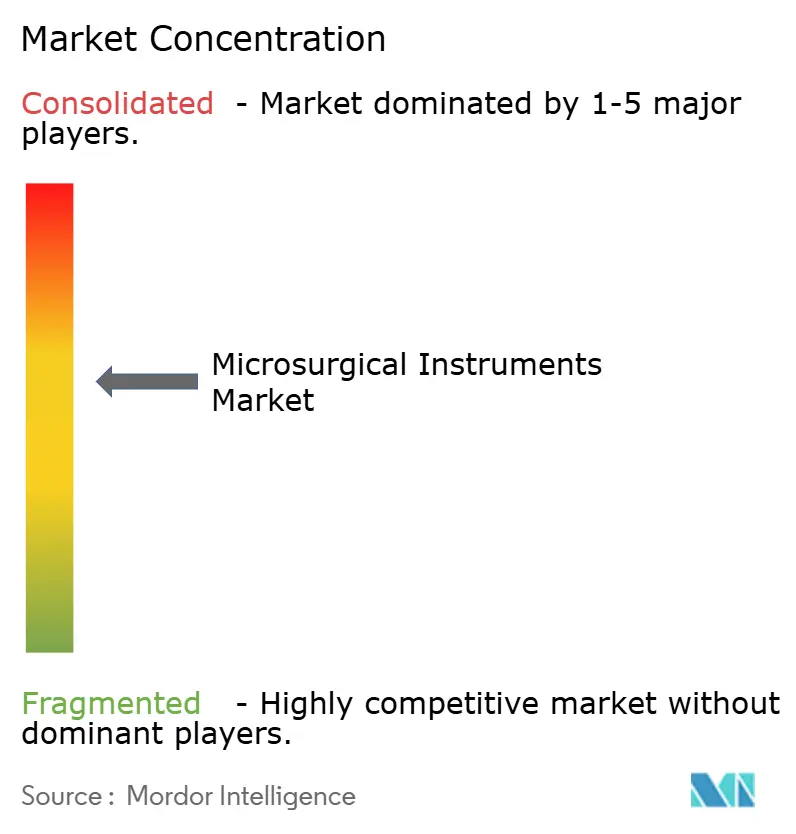


Recent Industry Developments
- May 2025: Virtuoso Surgical Inc. reported the first-in-human bladder cancer excision using its Virtuoso System, employing needle-sized manipulators to achieve en bloc tumor removal and reduce recurrence risk.
- February 2025: Teleflex Incorporated agreed to acquire BIOTRONIK’s Vascular Intervention business, adding drug-coated balloons and drug-eluting stents to its interventional toolkit.
Research Methodology Framework and Report Scope
Market Definitions and Key Coverage
Our study views the microsurgical instruments market as revenue derived from precision hand-held tools, micro forceps, micro scissors, micro sutures, needle holders, vessel clamps, and allied accessories used under an operating microscope to perform sub-millimeter procedures in ophthalmology, neurology, plastic-reconstructive, ENT, and orthopedic settings. Devices whose primary purpose is optical visualization rather than tissue manipulation are considered complementary, not core, to this market and are treated separately within Mordor Intelligence's broader surgical equipment framework.
Scope exclusion: powered robotic workstations and stand-alone operating microscopes fall outside our sizing universe.
Segmentation Overview
- By Product
- Micro Sutures
- Micro Forceps
- Operating Microscopes
- Micro Scissors
- Micro Needle Holders
- Micro Vessel Clamps
- Other Instruments
- By Microsurgery Type
- Orthopedic
- Ophthalmic
- Plastic & Reconstructive
- ENT
- Neurological
- Gynecological & Urological
- Other Types
- By End User
- Hospitals
- Ambulatory Surgical Centers
- Specialty Clinics
- Academic & Research Institutes
- Geography
- North America
- United States
- Canada
- Mexico
- Europe
- Germany
- United Kingdom
- France
- Italy
- Spain
- Rest of Europe
- Asia-Pacific
- China
- Japan
- India
- South Korea
- Australia
- Rest of Asia-Pacific
- Middle East and Africa
- GCC
- South Africa
- Rest of Middle East and Africa
- South America
- Brazil
- Argentina
- Rest of South America
- North America
Detailed Research Methodology and Data Validation
Primary Research
Mordor analysts interviewed practicing microsurgeons, peri-operative nurses, and instrument distributors across North America, Europe, India, and Japan. These discussions clarified kit replacement rates, titanium versus stainless adoption, and average selling price progression, enabling us to sharpen preliminary desk findings and close data gaps before final triangulation.
Desk Research
We compiled foundational data from open sources such as the US FDA 510(k) database, Eurostat trade codes for HS-901890, Japanese PMDA approvals, and clinical-procedure registries from the American Academy of Ophthalmology and the International Society of Plastic Surgeons. Company 10-Ks, Medicare outpatient claims, and selective insights from paid platforms including D&B Hoovers and Dow Jones Factiva enriched competitive and pricing intelligence. Numerous additional public-domain articles and association white papers were also reviewed to confirm trends and volumetrics; the list above is illustrative, not exhaustive.
Market-Sizing & Forecasting
A top-down build starts with annual procedure counts (e.g., cataract, free-flap transfers), applies instrument-per-case coefficients and replacement cycles, and is balanced through selected bottom-up checks such as sampled OEM revenues and channel audits. Key variables in our model include ophthalmic surgery volumes, neurosurgical microscope case growth, average reusable set lifespan, titanium raw-material costs, regulatory approval cadence, and hospital capital-budget trends. Multivariate regression on these drivers generates the 2025-2030 forecast, with scenario analysis used where volatility around input costs is high.
Data Validation & Update Cycle
Outputs undergo variance scans against independent shipment data and customs codes. Senior reviewers challenge anomalies, and any material market event triggers interim refresh ahead of the annual update. A final analyst pass precedes delivery, ensuring clients receive the latest vetted view.
Why Mordor's Microsurgical Instruments Baseline earns trust
Published figures often diverge because firms choose dissimilar scopes, price bases, and refresh rhythms. We focus strictly on hand-held precision tools, report manufacturer revenue at ex-factory level, and refresh models each year, which keeps our baseline lean yet timely.
Key gap drivers include rivals bundling microscopes and robotic consoles into instrument revenue, using list prices rather than blended ASPs, or extrapolating unit sales from limited import datasets without procedure cross-checks.
Benchmark comparison
| Market Size | Anonymized source | Primary gap driver |
|---|---|---|
| USD 228.97 million (2025) | Mordor Intelligence | - |
| USD 2.65 billion (2024) | Global Consultancy A | Includes microscopes and robots; uses list prices |
| USD 2.20 billion (2024) | Trade Journal B | Aggregates all minimally-invasive kits; limited primary validation |
| USD 5.94 billion (2024) | Regional Consultancy C | Broad "microsurgery" scope spanning implants and disposables |
The comparison shows that once narrower scope, validated ASPs, and yearly refresh are applied, Mordor Intelligence delivers a balanced, reproducible baseline that decision-makers can rely on with confidence.


Key Questions Answered in the Report
What is the current value of the microsurgical instruments market?
The market is valued at USD 228.97 million in 2025 and is set to rise to USD 323.41 million by 2030.
Which product segment leads revenue?
Operating Microscopes command the top spot with 29.52% microsurgical instruments market share in 2024.
Which region shows the fastest growth?
Asia-Pacific posts the highest forecast CAGR at 9.62% through 2030 due to large-scale healthcare investments and an expanding middle class.
Why are Ambulatory Surgical Centers important to future demand?
ASCs grow at 8.26% CAGR because minimally-invasive techniques allow complex cases to shift to cost-efficient outpatient settings, driving instrument purchases.
How do regulatory hurdles affect new product launches?
Class III approval pathways demand extensive clinical evidence, extending development timelines and increasing costs but ensuring patient safety.
Page last updated on:
